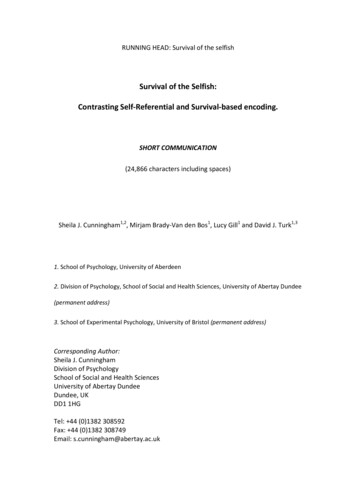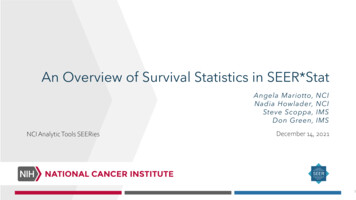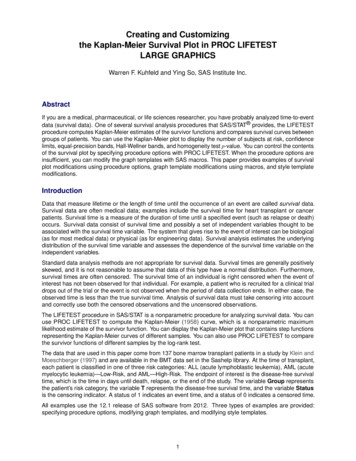
Transcription
RUNNING HEAD: Survival of the selfishSurvival of the Selfish:Contrasting Self-Referential and Survival-based encoding.SHORT COMMUNICATION(24,866 characters including spaces)Sheila J. Cunningham1,2, Mirjam Brady-Van den Bos1, Lucy Gill1 and David J. Turk1,31. School of Psychology, University of Aberdeen2. Division of Psychology, School of Social and Health Sciences, University of Abertay Dundee(permanent address)3. School of Experimental Psychology, University of Bristol (permanent address)Corresponding Author:Sheila J. CunninghamDivision of PsychologySchool of Social and Health SciencesUniversity of Abertay DundeeDundee, UKDD1 1HGTel: 44 (0)1382 308592Fax: 44 (0)1382 308749Email: s.cunningham@abertay.ac.uk
Survival of the SelfishAbstract:Processing information in the context of personal survival scenarios elicits a memoryadvantage, relative to other rich encoding conditions such as self-referencing.However, previous research is unable to distinguish between the influence ofsurvival and self-reference because personal survival is a self-referent encodingcontext. To resolve this issue, participants in the current study processed items inthe context of their own survival and a familiar other person’s survival, as well as in asemantic context. Recognition memory for the items revealed that personal survivalelicited a memory advantage relative to semantic encoding, whereas other-survivaldid not. These findings reinforce suggestions that the survival effect is closely tiedwith self-referential encoding, ensuring that fitness information of potentialimportance to self is successfully retained in memory.Key words: Memory; self; self-reference effect; survival; fitness value1
Survival of the Selfish1. INTRODUCTION1.1 Survival-related processingMemory researchers have identified adaptive qualities of encoding and retrievalthat allow fitness information (i.e., that concerning survival and reproduction) to bepreferentially processed (Klein, Cosmides, Tooby, & Chance, 2002; Kang, McDermott& Cohen, 2008; Nairne, 2005; Nairne & Pandeirada, 2008a, 2008b, 2010; Nairne,Thompson & Pandeirada, 2007; New, Cosmides, & Tooby, 2007; Öhman & Mineka,2001). It is posited that ecological pressures encountered in the ancestralenvironment of the Pleistocene savannah led to the evolution of specific processingbiases in relevant domains such as physical survival (i.e., food, shelter, danger),navigation, reproduction, social exchange, and kinship (Nairne & Pandeirada,2008b). Of these domains, memory research has focused on physical survival-relatedprocessing, demonstrating a robust memory advantage for items encoded in asurvival context over non-survival related items (e.g., Burns, Burns, & Hwang, 2011;Kang et al., 2008; Nairne et al., 2007; Nairne & Pandeirada, 2008a, b; Öhman &Mineka, 2001; Weinstein, Bugg, & Roediger, 2008).The body of research on survival-related memory has grown from a paradigmdeveloped by Nairne et al. (2007). In this study, participants were asked to rate itemsfor importance in the context of a surviving in a foreign grassland, before their itemmemory was assessed. Memory for this ‘survival-related’ information wascontrasted with memory for information encoded in a non-survival related context(rating the importance of items if moving to a new home abroad), and other2
Survival of the Selfishcontexts known to elicit superior memory performance (rating words forpleasantness and self-relevance). Nairne et al. found that compared to all the nonsurvival related tasks tested, the survival-based encoding led to higher recall andrecognition, suggesting that memory systems are indeed ‘tuned’ for fitness value.Consolidating this conclusion, subsequent studies have shown that the memoryadvantage associated with survival-based encoding is maximized in contexts thatmimic the hunter-gatherer environment. For example, survival-related processingelicits a greater advantage when ancient grasslands rather than modern city contextsare evoked at encoding (Nairne & Pandeirada, 2010; Weinstein et al., 2008), andwhen specific hunter-gatherer goals are involved (e.g., searching in the grasslandsfor food to eat v. searching for the same items in a team scavenging game - Nairne,Pandeirada, Gregory, & Van Arsdall, 2009). Together, these studies build acompelling argument for the existence of an adaptive, context-dependent encodingbias that ensures information relating to personal survival is successfully retained.1.2 The self in survivalAn interesting aspect of the memory bias for survival-related information, andthe focus of the current inquiry, is the extent to which it is associated with selfreferential processing biases (see Burns et al., 2011; Klein, 2012). As Nairne et al.(2007) acknowledge, processing personal survival is clearly a self-referentialencoding context. Indeed, as Klein comments, “few things are more self-relevantthan one’s own survival” (2012, p. 2, emphasis added).3
Survival of the SelfishThis self-processing and survival-processing conflation is of theoreticalinterest because encoding information in a context of self-relevance also elicits astrong memory bias (the self-reference effect (SRE) in memory - Rogers, Kuiper &Kirker, 1977). The SRE has received an enormous amount of empirical attention formore than three decades, so that we now have a rich understanding of themechanisms through which it is elicited (for review, see Symons & Johnson, 1997).There is evidence that self-referencing promotes better organization in memory, andleads to relatively rich representations due to elaboration by the detailed andaccessible self-concept (Klein & Kihlstrom, 1986; Klein & Loftus, 1988; Symons &Johnston, 1997). Recent research also suggests that automatic responses to selfreference such as increased attention and physiological arousal may also contributeto the rich, elaborative encoding that characterizes self-referential memories (Turk,Cunningham, & Macrae, 2008; Turk, Van Bussel, Waiter, & Macrae, 2011a; Turk, VanBussel, Brebner, Toma, Krigolson, & Handy, 2011b). If the survival effect is related toself-referential processing, then such explanations could provide a useful account ofthe proximate mechanisms underlying the impact of survival-related encoding onmemory.Nairne et al. (2007) make the valid point that survival-related retention in theirexperiments exceeded control conditions that evoked self-reference (i.e., decidingwhat items would be necessary for a personal move abroad). However, Klein (2012)has pointed out concerns with these tasks. In particular, the self-referencing taskused by Nairne et al. may have failed to elicit self-referential memories becauseparticipants were asked to rate the likelihood of items evoking autobiographicalmemories, rather than instructed to recall the memories themselves. Klein4
Survival of the Selfishreplicated Nairne et al.’s experiments using a more standard self-referentialinstructions and found that the memory advantage for survival-based over selfreferential processing was rendered non-significant.Interestingly, the effect of ‘removing’ the self from survival tasks has beenexplored previously. Weinstein et al. (2008) employed a between groups design tocontrast memory from both first and third-person survival encoding tasks (i.e., ratingwords in relation to survival of self, friend or a stranger), and found a similar effect ineach referent condition. Further, Kang et al. (2008) found that processinginformation in terms of its fitness for survival enhanced memory performance evenwhen the referent was a cartoon character. However, an issue with both of thesestudies is that they use a between groups design – when participants are imagingwhat another person would do in a survival context that is unfamiliar to them, it islikely that they would project self to complete the task (i.e., “If it were me trying tosurvive, I would need ”). It may be that the utilization of a between groups designdoes not elicit the necessary self-other distinction at encoding. The current inquiryseeks to overcome this issue and provide a direct test of the influence of selfreferential versus survival-based encoding on subsequent memory.1.3 The current inquiryThis inquiry sought to directly compare self- and other-survival using a variationof Nairne et al.’s (2007) grassland survival task. In a repeated-measures experiment,participants were asked to rate the usefulness of items in the context of their own5
Survival of the Selfishsurvival in a grasslands context, or the survival of a familiar other person. A semanticencoding context was also included for contrast. By specifically generating the needfor a self versus other contrast at encoding we predicted that an advantage forsurvival-related processing over semantic processing would be found when thereferent is self, which would be attenuated or eliminated in the other-referentcondition.2. METHOD2.1 Participants and designForty undergraduate students (25 females, mean age 19.1 years) from theUniversity of Aberdeen took part in the experiment in return for course credits. Allparticipants had normal or corrected-to-normal eyesight. Participants gave informedconsent in accordance with the guidelines set by the University of Aberdeen’sPsychology Ethics Committee. A single-factor (Encoding condition: Self, Other,Semantic) within-subjects design was employed.2.2 Procedure and stimulus materialsParticipants were tested individually and the experiment was delivered using Eprime version 1.1 experimental software (Psychology Software Tools Inc., Pittsburgh,PA). A total of 180 objects derived from the Clark and Paivio (2004) norms, weresorted into six lists of 30 items each, matched for familiarity, imagery and frequency.6
Survival of the SelfishAt encoding, one list was presented in a ‘self’ condition block, one in the ‘other’condition block and one in the ‘semantic’ condition block. The three remaining listswere reserved for use as foils in the subsequent recognition test. The use of lists asself, other, semantic or test lists was counterbalanced across participants. Blockorder was also counterbalanced across participants, and item order was randomisedwithin each block. Instructions as to how the items should be rated were given at thestart of each block and were as follows:Self condition: “In this task, try to imagine that you are stranded in thegrasslands will need to find steady supplies of food, water and protect yourselffrom predators. You will now be shown a list of words and you are asked to ratetheir relevance to you in this survival situation on a scale of 1-5 (1 being notrelevant and 5 being extremely relevant). Some of the words may be relevantand others may not. It is up to you to decide.”Other condition: “In this task, try to imagine that David Cameron is stranded inthe grasslands of a foreign land, without basic survival materials. Over the nextfew months he will need to find steady supplies of food, water and protecthimself from predators. You will now be shown a list of words and you are askedto rate their relevance to David Cameron’s survival situation on a scale of 1-5 (1being not relevant and 5 being extremely relevant). Some of the words may berelevant and others may not. It is up to you to decide.”Semantic condition: “In this task, you will be presented with a series of words,some of these items can be found in the city, others in nature or sometimes inboth. You will be asked to rate these words as follows: 1 Only found in the city,7
Survival of the Selfish2 Mostly found in the city, 3 Found in both city and nature, 4 Mostly found innature, 5 Only found in nature. It is up to you to decide.”Participants entered their responses via a keypress. Following the encoding phase,participants performed a 10-min digit recall filler task, after which a self-pacedsurprise recognition test was administered. The 90 previously-presented (Old) itemsand 90 New items were presented individually in a random order. Participantsresponded with an Old or New keypress.3. RESULTSEight participants demonstrated poor performance on the rating task with morethan 10% of words in any condition being unrated within the timeframe allowed.Analysis was therefore confined to the 32 remaining participants.3.1 Recognition accuracy dataProportional hit scores and false alarm scores calculated and transformed toaccuracy scores to correct for guessing1. These scores were submitted to a singlefactor ANOVA (encoding condition: self, other, semantic). Mauchly’s test indicatedAn accuracy score was calculated to correct for guessing following the procedureoutlined by Snodgrass and Corwin (1988):Hit Rate (Number of Hits .5)/(Total possible hits 1)False Alarm Rate (number of false alarms .5)/(Total possible false alarms 1)Accuracy score Hit Rate – False Alarm Rate18
Survival of the Selfishthat the assumption of sphericity had been violated (χ2(2) 16.8, p .001),therefore degrees of freedom were corrected using Greenhouse-Geisser estimatesof sphericity (ε .78). This showed a significant main effect of encoding condition,F(1.57,48.72) 9.03, p .001, η2 .23, see Figure 1A. Planned contrasts indicatedsignificant differences between the self-survival and other-survival condition, t(31) 2.76, p .01, and between the self-survival condition and semantic condition, t(31) 5.85, p .001. However, there was no observed difference in memory performancebetween the other-survival and semantic condition, t(31) 1.04, p .31. Theseresults indicate that memory performance is significantly better following selfsurvival encoding than following either other-survival or semantic encoding. Theother-survival scenario did not elicit a memory advantage.3.2 Ratings and response latenciesParticipants’ tendency to provide high or low ratings for the 30 items in eachcondition was contrasted to exclude rating bias. Mean rating values were calculatedfor each participant for the three encoding conditions (see Figure 1B), and subjectedto a one-way ANOVA (Encoding Condition: self, other, semantic). This revealed nosignificant main effect of condition on fitness ratings F(2,62) 1.65, p .2, η2 .05.Average response latencies for the ratings for each condition are shown in Figure1C. An ANOVA revealed a significant effect of encoding condition, F(2,62) 6.71, p .005, η2 .18. Response times for self- and other-survival did not differ, t(31) -.74,p .46. However latencies for the semantic task were significantly longer than for9
Survival of the Selfishself-survival, t(31) -3.43, p .005, and other-survival conditions, t(31) -2.56, p .015. These data suggest that in line with previous research (e.g., Nairne et al., 2007)effortfulness at encoding did not predict memory retention.[FIGURE 1 ABOUT HERE]4. DISCUSSIONThe current enquiry asked a simple question: does the memory-enhancing effectof survival-related encoding arise when survival is not personal? Our findings suggestthat the answer to this question is no; when participants encoded information in thecontext of a familiar other person’s survival, no significant memory advantage (oversemantic encoding) accrued. In contrast, when information was encoded in thecontext of personal survival, the standard memory enhancement effect was found.This self-survival advantage was not underpinned by increased fitness ratings, norwas it indexed by differences in response latency compared with the other-survivalcondition. The current data therefore illustrate that human memory systems maywell have been tuned for survival (Nairne al., 2007), but that this tuning isfunctionally specific the continued existence of the self.4.1 Linking the self and survivalGiven the theoretical overlap between the self and personal survival, it is notsurprising that the independent contribution of these processing biases has proved10
Survival of the Selfishdifficult to reliably assess. For example, while Nairne et al. (2007) reported amemory advantage following survival-related encoding but not self-referencing,Klein (2012) has shown the effects of the two to be equivalent. Somewhat counterintuitively, previous research suggested that a survival encoding advantage can beobserved for a third person such as a character in a video clip (Kang et al., 2008), andcan be equivalent across self-referent and other-referent survival processingconditions (Weinstein et al., 2008). However, in both of these studies participantswere only required to process items in relation to the survival of a single referent,perhaps prompting self-projection (i.e., using self-survival thoughts to determine therelevance of items to other referents). Using a within-subjects design to reduce theinfluence of self-projection, the current findings clarify the impact of referent onsurvival processing.What the current study offers is an exploration of survival-based processing fromthe paradigm perspective of the SRE literature, in which it accepted that tounderstand the role of the self, self-referent processing should be directly comparedwith other-referent processing (see Symons & Johnson, 1997). Like the much of thecurrent survival research, early SRE studies compared self-referencing with otherencoding strategies such as semantic processing and physical properties (e.g.,Rogers et al., 1977). It has become more standard to closely match encodingconditions to directly compare self- and other-reference, allowing a more confidentassertion of the influence of the self. The value of the current study is that for thefirst time, to our knowledge, this same approach is applied in the survival literature.Thus we can confidently conclude that the self is a critical element to the survival11
Survival of the Selfisheffect; the encoding context of other people’s survival clearly does not evoke thesame processing biases as consideration of one’s own survival.It is important to note that, like Klein (2012), we do not suggest that the survivaleffect can be reduced to an artefact of self-referential processing. The body ofresearch demonstrating that grassland encoding contexts and hunter-gatherer goalsare particularly effective at eliciting a memory advantage provide strong evidencefor an adaptive, functional property of memory (e.g., Nairne et al., 2007; Weinsteinet al., 2008). However, what is clear from the current inquiry is that like grasslandsettings and hunter-gatherer goals, self is a critical element of the encoding contextthat gives rise to a survival-related memory advantage.4.2 Personal survival goalsThe influence of the self in a survival context may reflect the failure of otherpeople’s survival to activate relevant goals. The role of task goals in survival-relatedencoding has been highlighted by research showing heightened memory for survivalitems when hunter-gatherer goals are evoked (e.g., location for food in a survivaltask vs. a scavenging game – Nairne al., 2009). Further, congruent goals can mimicsurvival effects, such that non survival-related items that are less likely to be recalledin a survival task, are more likely to be recalled if they are relevant to the goal in theencoding context (e.g., an alarm in the context of a burglary – Butler, Kang, &Roediger, 2009). This congruence effect is not surprising as current goals have beenshown in other spheres of memory research to be highly influential in determining12
Survival of the Selfishencoding effects (see Moskowitz, Gollwitzer, Wasel, & Schaal, 1999). Current taskgoals effectively prime relevant information in memory, supporting the encoding ofcongruent over incongruent items. What the current research makes clear is thatnon-self-relevant processing goals may be ineffective at eliciting a memoryadvantage; scenarios involving other people’s survival goals are simply less effectiveencoding devices.This specificity to self is logical in the context of ecological pressures. There is anadvantage in remembering information related to oneself. This importance isreflected in our attention to self-relevant stimuli – whether this comprises catchingone’s own name in a group discussion (Cherry 1953; Moray, 1956), rememberingexperiences that have happened to oneself (Conway & Dewhurst, 1995), or keepingtrack of one’s possessions (Cunningham, Turk, MacDonald, & Macrae, 2008). Aspointed out elsewhere, “while we are all likely to notice the sound of glass breakingin our vicinity, we are likely to attend to it more, and process it more deeply, whenour memory and inference mechanisms identify it as the sound of OUR glassbreaking.” (Wilson & Sperber, 2004, p. 610 (emphasis added), quoted by Friedman &Ross, 2011). In terms of memory functionality, then, it seems plausible to suggestthat the survival effect is driven by a combination of survival-based priming and thefrequently activated goal of attending and retaining any information that is relevantto self. Like taking the hunter-gatherer goal out of the encoding context, taking selfout of the survival context removes the immediate value of the processing bias andreduces the impact on memory accordingly.13
Survival of the Selfish4.3 Proximate causesOne advantage of exploring the link between the memory effects associated withsurvival-based and self-referential encoding is that it offers potential insights intothe proximate mechanisms that are likely to drive the memory advantage forsurvival-based processing. While these are not explored directly in the currentinquiry, speculative interpretations suggests a rich potential for future research.The SRE has been explored widely in behavioral research using a range ofencoding and retrieval strategies, and more recent neuroimaging studies offer newinsights (Gray, Ambady, Lowenthal, & Deldin, 2004; Turk et al., 2011a,b). Theenriched encoding and relational processing advantages offered by both survivalrelated and self-referential processing are discussed in depth elsewhere (Burns et al.,2011; Klein, 1012). However, we suggest that empirical attention be applied toadditional mechanisms identified in SRE research, based on increased arousal andattention capture. An emotional basis to the SRE has been proposed (Turk et al.,2011a), combined with an increase in attentional resources directed to self-relevantinformation (Bargh, 1982; Gray et al., 2004; Turk et al., 2011b), which combine toenhance memory for self-relevant material even when the self-item association isminimal (Turk et al., 2008). The grasslands survival effect has previously beendiscussed in terms of increased arousal (Weinstein et al., 2008), although Nairne etal. (2007) have argued against such an explanation for lack of plausibility, point outthat survival related words are not arousing. However the link between survival andself may render this account more conceivable. Like other aspects of self-processing,14
Survival of the Selfishconsidering one’s own survival is likely to be an arousing and attention-capturingencoding context (see Öhman, Flykt, & Esteves, 2001).A further avenue for future research would be to examine the interactionbetween referent and scenario in terms of survival-based processing. The ability tosurvive is not only a reflection of an organism’s fitness to adapt to the environment(which may include the ability to escape predation by other species), but also aboutcompetition for resources within its own species (i.e., competition with otherpeople). However, social and family relationships were critical to ancestral survival(hence Nairne & Pandeirada’s (2008b) suggestion that kinship is another domain inwhich evolved processing biases would be expected). SRE research hasdemonstrated that the mnemonic difference between self-referent and otherreferent information can be attenuated (even eliminated) when the other-referent isclosely connected to self, such as a parent or best friend (Bower & Gilligan, 1979;Symons & Johnson, 1997). It could be predicted, therefore, that if participants in thecurrent experiment had been asked to encode information in the context of theirmother’s survival, the pattern of recognition memory performance would have beenmore in line with self than David Cameron. This prediction notwithstanding, if thefunction of memory is to enhance fitness for survival, is seems plausible that themaximal benefit of this function would be the continued existence of the individualorganism; of the self. Our results demonstrably support this principle.15
Survival of the Selfish5. CONCLUSIONSThere is compelling evidence that a memory advantage can be produced byencoding information in ancestral scenarios, in the context of survival-related goals.Adding to this knowledge, the current inquiry clearly demonstrates that a criticalelement of the survival-related memory effect is the self: encoding information inthe context of survival by other people fails to elicit the standard memoryadvantage. This finding is compatible with the purported functional adaptations ofmemory, as well as providing an insight into the mechanisms that might give rise tosurvival effects on memory. In short, memory has adapted to preferentially processsurvival information, as long as the survival in question is one’s own.AcknowledgementsDJT was supported by a grant from the European Research Council (202893).16
Survival of the SelfishReferencesBargh, J. A. (1982). Attention and automaticity in the processing of self-relevantinformation. Journal of Personality and Social Psychology, 43, 425-436.Bower, G. H., & Gilligan, S. G. (1979). Remembering information related to one’s self.Journal of Research in Personality, 13, 420 - 432.Burns, D. J., Burns, S. A., & Hwang, A. J. (2011). Adaptive memory: Determining theproximate mechanisms responsible for the memorial advantages of survivalprocessing. Journal of Experimental Psychology: Learning, Memory, andCognition, 37, 206-218.Butler, A. C., Kang, S. H. K., & Roediger, H. L. (2009). Congruity effects betweenmaterials and processing tasks in the survival paradigm. Journal ofExperimental Psychology: Learning, Memory and Cognition, 35, 1477-1486.Cherry, E. C. (1953). Some experiments on the recognition of speech, with one andtwo ears. Journal of the Acoustical Society of America, 25, 975-979.Clark, J. M., & Paivio, A. (2004). Extensions of the Paivio, Yuille, and Madigan (1968)norms. Behavior Research Methods, Instruments, & Computers, 36, 371–383.Conway, M. A. & Dewhurst, S. A. (1995). The self and recollective experience.Applied Cognitive Psychology, 9, 1-19.Cunningham, S. J., Turk, D. J., MacDonald, L. M., & Macrae, C. N. (2008). Yours ormine? Ownership and memory. Consciousness and Cognition, 17, 312-318.17
Survival of the SelfishFriedman, O., & Ross, H. (2011). Twenty-one reasons to care about the psychologicalbasis of ownership. In H. Ross & O. Friedman (Eds.), Origins of ownership ofproperty. New Directions for Child and Adolescent Development, 132, 1–8.Gray, H. M., Ambady, N., Lowenthal, W. T., & Deldin, P. (2004). P300 as an index ofattention to self-relevant stimuli. Journal of Experimental Social Psychology,40, 216-224.Kang, S. H. K., McDermott , K. B., & Cohen, S. M. (2008). The mnemonic advantage ofprocessing fitness-relevant information. Memory & Cognition, 36, 1151-1156.Klein, S. B. (2012). A role for self-referential processing tasks requiring participants toimagine survival in the Savannah. Journal of Experimental Psychology:Learning, Memory and Cognition. Advanced online publication. doi:10.1037/a0027636.Klein, S. B., Cosmides, L., Tooby, J., & Chance, S. (2002). Decisions and the evolutionof memory: Multiple systems, multiple functions. Psychological Review, 109,306–329.Klein, S. B., & Kihlstrom, J. F. (1986). Elaboration, organization, and the self-referenceeffect in memory. Journal of Experimental Psychology: General, 115, 26–38.Klein, S. B. & Loftus, J. (1988). The nature of self-referent encoding - thecontributions of elaborative and organizational processes. Journal ofPersonality and Social Psychology, 55, 5-11.Moray, N. (1959). Attention in dichotic listening: Affective cues and the influence ofinstructions. Quarterly Journal of Experimental Psychology, 11, 55-60.18
Survival of the SelfishMoskowitz, G. B., Gollwitzer, P. M., Wasel, W., & Schaal, B. (1999). Preconsciouscontrol of stereotype activation through chronic egalitarian goals. Journal ofPersonality and Social Psychology, 77, 167-184.Nairne, J. S. (2005). The functionalist agenda in memory research. In A.F. Healy (Ed.),Experimental cognitive psychology and its applications (pp. 115–126).Washington, DC: American Psychological Association.Nairne, J. S. & Pandeirada, J. N. S. (2008a). Adaptive memory: Is survival processingspecial? Journal of Memory and Language, 59, 377-385.Nairne, J. S. & Pandeirada, J. N. S. (2008b). Adaptive memory: Remembering with aStone Age brain. Current Directions in Psychological Science, 17, 239-243.Nairne, J. S. & Pandeirada, J. N. S. (2010). Adaptive memory: Ancestral priorities andthe mnemonic value of survival processing. Cognitive Psychology, 61, 1-22.Nairne, J. S., Pandeirada, J. N. S., Gregory, K. J, & Van Arsdall, J. E. (2009). Adaptivememory: fitness relevance and the hunter-gatherer mind. PsychologicalScience, 20, 740-746.Nairne, J. S., Thompson, S. R. & Pandeirada, J. N. S. (2007). Adaptive memory:Survival processing enhances retention. Journal of Experimental Psychology:Learning, Memory and Cognition, 33, 263-273.New, J., Cosmides, L. & Tooby, J. (2007). Category-specific attention for animalsreflects ancestral priorities, not expertise. Proceedings of the NationalAcademy of Sciences, 104, 16598-16603.19
Survival of the SelfishÖhman, A., Flykt, A., & Esteves, F. (2001). Emotion drives attention: Detecting thesnake in the grass. Journal of Experimental Psychology: General, 131, 466478.Öhman, A., & Mineka, S. (2001). Fear, phobias and preparedness: Toward an evolvedmodule of f
survival and self-reference because personal survival is a self-referent encoding context. To resolve this issue, participants in the current study processed items in the context of their own survival and a familiar other person's survival, as well as in a semantic context. Recognition memory for the items revealed that personal survival







![[ST] Survival Analysis - Stata](/img/33/st.jpg)


